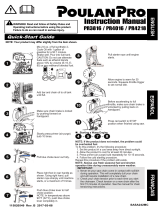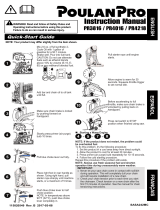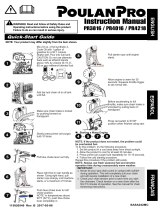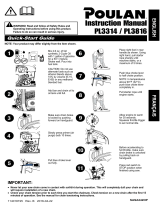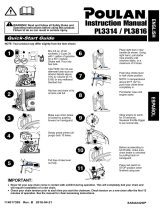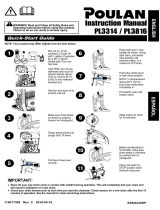
andT.Theyarelocatedinthearea just
above the primer bulb.
CARBURETOR PRESETS
When making adjustments, do not force
the plastic limiter caps beyond the
stops or damage will occur.
If carburetor presets are not needed,
proceed to "Idle Adjustments."
° Turn both mixture screws counter-
clockwise until they stop.
• Turn the idle speed screw clockwise
until it stops. Now turn counterclock-
wise 4-1/2 turns.
Start motor, let it run for 3 minutes, and
proceed to the adjustment section. If
engine does not start, refer to trouble-
shooting chart or call 1-800-235-5878.
If engine performance is acceptable at
the preset positions and there is no
chain movement at idle, no further ad-
justment is necessary.
ADJUSTING PROCEDURE
Idle Speed "T"
Allow engine to idle. Adjust speed until
engine runs without chain movement or
stalling.
° Turn clockwise to increase engine
speed if engine stalls or dies.
• Turn counterclockwise to decrease
speed.
No further adjustments are necessary if
chain does not move at idle speed and
if performance is satisfactory.
Low Speed Mixture "L"
Allow engine to idle. Then accelerate
the engine and note performance. If en-
gine hesitates, bogs down, or smokes
during acceleration, turn mixture screw
clockwise in lt16-tum increments until
performance issatisfactory. Repeat this
procedure as necessary for proper ad-
justment. After completing adjustments,
check for acceleration and chain move-
ment at idle. Reset if necessary.
High Speed Mixture "H"
DO NOT operate engine at full throttle
for prolonged periods while making ad-
justments, Damage to the engine can
occur. Make a test cut. Based on per-
formance of the saw while cutting, ad-
just the high speed mixture setting in
1/16-turn increments as follows:
• Clockwise until the saw has good
power in the cut with no hesitation.
Do not adjust by sound or speed, but
judge by how well the saw performs in
the cut.
• Counterclockwise if the saw has
speed, but dies in the cut or lacks
power in the cut.
After completing adjustments, check for
acceleration and chain movement at
idle. Reset if necessary.
Acceleration Check
If the engine dies or hesitates instead of
accelerating, turn the low speed mixture
adjustment counterclockwise until you
have smooth acceleration with no chain
movement at idle. Recheck and adjust
as necessary for acceptable perfor-
mance.
Prepare yourunitfor storage at theend EXTERNAL SURFACES
of the season or if it will not be used for
30 days or more.
WARNING:
• Allow the engine to cool, and secure
the unit before storing or transporting.
• Store chain saw and fuel in a well
ventilated area where fuel vapors
cannot reach sparks or open flames
from water heaters, electric motors or
switches, furnaces, etc.
° Store chain saw with all guards in
place and position chain saw so that
any sharp object cannot accidentally
cause injury.
• Store chain saw well out of the reach
of children.
If your chain saw isto be stored for a
period of time, clean itthoroughly be-
fore storage. Store in a clean dry area.
• Lightly oil external metal surfaces and
guide bar.
* Oil the chain and wrap it in heavy pa-
per or cloth.
FUEL SYSTEM
Under Fueling Engine in the Operating
Section of this manual, see message
labeled IMPORTANT regarding the use
of gasohol in your chain saw.
Fuel stabilizer is an acceptable alterna-
tive in minimizing the formation of fuel
gum deposits during storage. Add stabi-
lizer to the gasoline in the fuel tank or
fuel storage container. Follow the mix
16




















